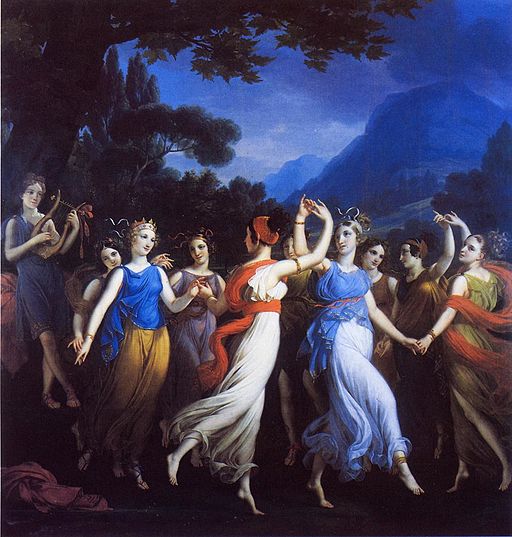 One of the many things I love about the movie Dogma is Salma Hayek’s portrayal of The Muse – a feminist spirit determined to create her own art, reduced to dancing in a strip club where the patrons are consistently struck with great ideas. The creative muse is always portrayed as female, perhaps because artists in the past have usually been male. Or at least, female artists have not seemed to rely as heavily on the idea of the muse. Perhaps because women have seldom had access to that room of one’s own that offers the luxury of a tryst with the muse, female artists have had to take a more workmanlike approach to their art.
One of the many things I love about the movie Dogma is Salma Hayek’s portrayal of The Muse – a feminist spirit determined to create her own art, reduced to dancing in a strip club where the patrons are consistently struck with great ideas. The creative muse is always portrayed as female, perhaps because artists in the past have usually been male. Or at least, female artists have not seemed to rely as heavily on the idea of the muse. Perhaps because women have seldom had access to that room of one’s own that offers the luxury of a tryst with the muse, female artists have had to take a more workmanlike approach to their art.
Women have had to hold on to inspiration until the toddler’s naptime, to generate creative energy after the rest of the family has gone to bed or capture ideas on the commuter train. In other words, women create when they can, not when they feel like it. Perhaps if more women were free to create in the bohemian artiste sense of having nothing else to do, they would give more weight to the idea of the muse. Maybe then we’d have paintings of The Muse that resembled Chris Hemsworth from the movie Thor. (Hmm, Thor did inspire Natalie Portman’s character to perform great science…)
Do I have a muse?
I have not often considered the concept of the muse in my own work. As a lab tech, as a grad student, as a technical staff writer, I have always written to fulfill an assignment against a deadline. I wrote what was needed when it was needed and my personal feelings about it were irrelevant. Really, what personal feelings would I have about an assignment on the pests and diseases affecting the blue spruce or the capital asset maintenance program performance evaluation? This kind of writing is purely a matter of technical skill. I just convey the relevant technical information clearly and concisely for the lay reader. There’s no creative element in that – right? Right?
Recently I have noticed that my output, both at the day job and in my own writing, is not constant. (This is the part where more experienced writers may snicker at my naiveté and mumble some literary equivalent of, “Well, duh.”) As much as I love Salma Hayek, maybe I would have been quicker to notice the muse if it had been portrayed by Ed Norton.
Even within the constraints of assignments and deadlines, there are times and projects when I sit down to work and just write. I start at the beginning and type until I’m done. At other times, on other projects, I can’t seem to get a word onto the screen. I procrastinate and do “research.” Even when I’m really disciplined and force myself to sit in front of a blank screen for hour after grueling hour, I can only squeeze out half a page – that I later end up completely rewriting. Sometimes the assignment is particularly juicy or dry, but the correlation between topic and inspiration is weak. I must conclude that the difference lies in me. Sometimes the muse is with me, and sometimes he isn’t.
Loafing
In the book Bluebird, Ariel Gore identifies “loafing” as a critical component of creativity and of leading a happy life. She claims the unproductive-looking down times are critical to creating balance in your mind and in your life. Constant output without taking breaks will cause the well to run dry and loafing allows you to create the internal space for new ideas. Loafing invites the muse.
Some weeks my time would be better spent wandering the arboretum, playing with my kids, or even folding laundry, than staring at the screen. In time, the muse (‘fear of deadline’ portrayed by Jack Nicholson maybe?) shows up, and the assignment practically writes itself. Whether I loaf or stare at the screen, I don’t seem to finish any sooner or later. If there is a difference in quality between the torturous and the hastily written, the ones I mechanistically force out are the inferior, clunky products.
I can take a week or a month away from the laptop. But the day job frowns on divas, so I don’t have the option of saying, “I’m sorry, I just can’t feel employee recognition today. I’m going for a walk and maybe I can write your piece tomorrow.” The need for consistent productivity has cost many a valuable hour of loafing. But I am learning to recognize the muse, and within the constraints of regular work, I am beginning to know how not to waste the days he visits. If you walk by my cube and find me cleaning my keyboard with a q-tip, I am not wasting time. I am loafing. It is very important, and yes, it does have to be done now.
For the record, this is what my muse looks like.





About the author